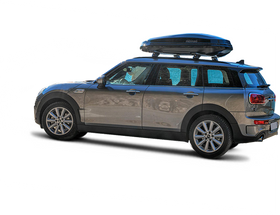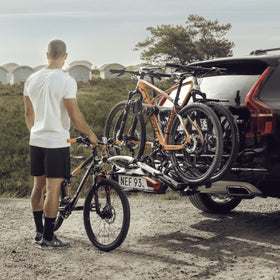
Before heading out, it’s crucial to verify that any items attached to your vehicle—be they just roof bars or a full setup with a roof box and additional carriers—are properly and securely fitted. In the following sections, we’ll share some key tips to help ensure your journey is as safe as possible.

Check the Load Is Secure
In line with Highways England guidelines and the official Highway Code, you must ensure any load on your vehicle’s roof is properly fastened and does not protrude dangerously. An improperly secured load can damage your vehicle and pose a serious hazard to other road users.
Refer to your roof bar/accessory manufacturer’s instructions to correctly tighten every component. If you’re carrying longer items—like ladders—ensure they’re firmly tied down to prevent lifting off in high winds. To warn other motorists, attach high-visibility markers if anything extends beyond the vehicle’s length or width.
According to Highways England advice, regularly inspect your roof fittings—especially if you frequently carry loads. Vibrations from driving can gradually loosen bolts or straps, so a quick check before each journey helps minimize risks to both you and other road users.
For more official guidance on load safety, refer directly to the Highway Code or visit Highways England for updates and further resources.

Check for Speed Limits and Consider Your Vehicle’s Handling
When driving with a roof box or additional carriers, your car’s handling will be noticeably different—especially at higher speeds. Although many accessories are designed to be used at motorway speeds, it’s essential to refer to both the manufacturer’s instructions and official guidance from Highways England for any recommended limits.
A heavier, top-loaded vehicle is more susceptible to wind and may not corner as quickly. Its stopping distance also increases, so leave extra space between you and the vehicle in front. You can review detailed speed limit rules in the Highway Code to ensure compliance.
Carrying multiple bikes or a roof box can raise your car’s center of gravity, making it less stable at high speeds or during sudden maneuvers. Monitor your handling, especially if road or weather conditions are poor. Lowering your speed and being cautious when turning or braking can significantly enhance safety for both you and other road users.
For further information on speed limits and safe driving with heavy or oversized loads, consult Highways England and the Highway Code. By staying informed and adapting your driving habits, you’ll help prevent accidents and ensure a smoother journey.

Check the Height of the Load
Carrying items on your vehicle’s roof—such as a roof box or bicycles—increases overall height, which can limit access to garages, multi-storey car parks, and other spaces with clearance restrictions. According to Rule 98 of the Highway Code, drivers must ensure their load does not exceed height limits or create hazards.
Use a tape measure to find your vehicle’s total height with roof equipment attached. Keep this measurement handy (e.g., noted on the dashboard), so you can compare it against posted restrictions before entering low-clearance areas.
Striking a barrier or ceiling can damage both your vehicle and any rooftop gear. The Carrying Loads on Light Vehicles guidance from GOV.UK recommends taking extra care with loads that modify your vehicle’s dimensions. By planning ahead and checking height limits, you reduce the risk of collisions and unwanted repair expenses.
Refer to the Highway Code and GOV.UK’s load-carrying guidelines for more detailed information on safe driving practices and legal requirements.

Check the Weight Limit and Ensure Items Are Loaded Evenly
Paying close attention to weight limits is vital for both safety and legal compliance. As noted in Carrying Loads on Light Vehicles (GOV.UK guidance), each set of roof bars or accessories comes with its own maximum weight capacity. Exceeding this capacity can lead to equipment failure, expensive repairs, and potential legal repercussions.
If your roof bars are rated for 75kg, for example, make sure the combined weight of the bars, any roof box, and the contents inside doesn’t surpass that limit. Check the manufacturer’s guidelines to confirm specific capacities, and remember that heavier aluminum bars may allow for a higher load compared to steel bars.
Properly spacing out items—like multiple cycles—across the full width of the roof bars helps maintain balance. For a roof box, placing heavier objects at the bottom lowers the vehicle’s center of gravity, improving stability and handling. By following Highway Code Rule 98—which covers carrying loads safely—you can reduce the risk of accidents and ensure a safer journey for everyone on the road.
Ready to Find the Perfect Roof Bars?
Now that you’ve reviewed our safety tips, it’s time to pick the ideal roof bars for your vehicle. Simply use our registration lookup to instantly find compatible options, or, if you don’t have your reg handy, search by vehicle make, model, and year. This quick process ensures you get the right fit and can drive away with confidence—knowing your roof bars are both safe and perfectly matched to your car.
Confirm Your Vehicle
Make: FORD
Model: FOCUS ZETEC TDCI 109
Body Style: 5 DOOR HATCHBACK
Colour: Silver
Year of Manufacture: 2010
Fuel Type: DIESEL
Select your vehicle









